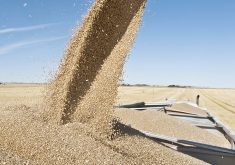Buoyancy has returned to the Canadian cattle industry after eight years of struggle.
“We are seeing calves trading at levels that I haven’t seen since pre- BSE,” said Jason Danard of Calgary Stockyards.
Cattle numbers in western Canadian auction rings are at lower levels and internet sales are steady compared to past feeder runs, but prices for all weight classes are the strongest since 2002.
A smaller cow herd is producing fewer calves. As well, this fall’s poor harvest has resulted in an ample feed wheat supply.
Read Also

Soybean market still figuring out implications of China-U.S. pact
Soybean futures had a muted reaction to the U.S. trade deal with China as the market tries to figure out the nuances of the deal.
No one is sure how much feed wheat is available, but the added supply has made feeding cattle in western feedlots competitive again.
Indeed, U.S. calves are trading lower so some Montana feeders are making their way into Alberta and British Columbia.
“The power is all in Canada right now,” Danard said.
But stronger prices do not appear to have sparked herd rebuilding.
In fact the opposite is happening with strong prices encouraging more producers to sell their herds or place more heifers on feed rather than retain them for breeding.
“The good cow prices are just enough to encourage guys to liquidate and get out and take the money and run,” said market analyst Brian Perillat of Canfax.
Producers are optimistic, but many believe the next livestock census will point to further reduction in Canadian and U.S. cattle numbers.
“The U.S. cow-calf and stocker sectors have had quite a profitable run, but they continue to liquidate. A lot of the demographics and land use challenges are similar in both countries,” Perillat said.
“We definitely will need a lot more money on the cow side to see expansion happen.”
Canfax reports that fed cattle prices peaked at the end of October at $95.83 per hundredweight.
A large regional feed supply, a narrow basis and the Canadian dollar flirting at par have encouraged Canadian feedlots to fatten animals born in the U.S.
“From a cattle feeding perspective, it is better to feed cattle up here this year than it is in the U.S., simply because of the cost of grain,” said Dave Guichon of Feedlot Strategies in Calgary.
“Corn value is much more expensive down there and because of the amount of feed we’ve got up here, that is helping to keep feed costs at a reasonable level (compared) to the U.S. If we didn’t have feed wheat here, our barley price would be 20 percent higher.”
He speculates that at least one-third of the wheat crop will be downgraded to feed.
Finding 48 pound barley may be a challenge, but feedlots will make available grain work in their rations.
Guichon expects little if any dried distillers grain will be used in Canada because $6 a bushel corn does not make it economical.
And corn might be headed higher. Lower yields reported in the U.S.
corn and soybean crop last week means grain producers can expect a bullish feed market, said analyst Errol Anderson of Pro Market Communications.
“(Corn) appears ripe to break above $6 a bu.,” he said.
“There is some talk in the U.S. that corn might have the wherewithal to move up towards $7. As a result, barley will move higher, even though there is a lot of feed wheat.”
The old rules of supply and demand may not apply this year. U.S. economic policies designed to encourage economic growth and create jobs are creating an inflationary effect on commodities.
“We are looking at outside markets – what is happening with stock markets, what is happening with the U.S. dollar, what is happening to crude oil,” Anderson said.
“Those have almost more of an effect on the value of grains than supply and demand itself.… This is a diamond in the rough. These grain prices really look like they are going to go higher.”
Tight cattle supplies are supporting beef prices, but the market has to be cautious because there is a large amount of competing pork and poultry, and grain prices are volatile.
“Even if the supplies are tight going into spring for corn, soybeans and super hot canola, the markets can still fail if the equity markets fail,” Anderson said.















